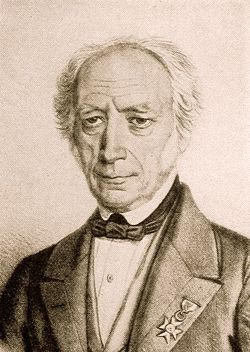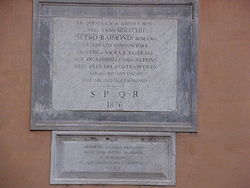
Pietro Raimondi
Encyclopedia

Italy
Italy , officially the Italian Republic languages]] under the European Charter for Regional or Minority Languages. In each of these, Italy's official name is as follows:;;;;;;;;), is a unitary parliamentary republic in South-Central Europe. To the north it borders France, Switzerland, Austria and...
composer, transitional between the Classical and Romantic
Romantic music
Romantic music or music in the Romantic Period is a musicological and artistic term referring to a particular period, theory, compositional practice, and canon in Western music history, from 1810 to 1900....
eras. While he was famous at the time as a composer of opera
Opera
Opera is an art form in which singers and musicians perform a dramatic work combining text and musical score, usually in a theatrical setting. Opera incorporates many of the elements of spoken theatre, such as acting, scenery, and costumes and sometimes includes dance...
s and sacred music, he was also as an innovator in contrapuntal
Counterpoint
In music, counterpoint is the relationship between two or more voices that are independent in contour and rhythm and are harmonically interdependent . It has been most commonly identified in classical music, developing strongly during the Renaissance and in much of the common practice period,...
technique as well as in creation of gigantic musical simultaneities.
Raimondi was born in Rome, and received his early education in Naples
Naples
Naples is a city in Southern Italy, situated on the country's west coast by the Gulf of Naples. Lying between two notable volcanic regions, Mount Vesuvius and the Phlegraean Fields, it is the capital of the region of Campania and of the province of Naples...
. He spent part of his early career in Genoa
Genoa
Genoa |Ligurian]] Zena ; Latin and, archaically, English Genua) is a city and an important seaport in northern Italy, the capital of the Province of Genoa and of the region of Liguria....
, and then in Sicily
Sicily
Sicily is a region of Italy, and is the largest island in the Mediterranean Sea. Along with the surrounding minor islands, it constitutes an autonomous region of Italy, the Regione Autonoma Siciliana Sicily has a rich and unique culture, especially with regard to the arts, music, literature,...
, where he had operas performed in Catania
Catania
Catania is an Italian city on the east coast of Sicily facing the Ionian Sea, between Messina and Syracuse. It is the capital of the homonymous province, and with 298,957 inhabitants it is the second-largest city in Sicily and the tenth in Italy.Catania is known to have a seismic history and...
and Messina
Messina, Italy
Messina is the third largest city on the island of Sicily, Italy and the capital of the province of Messina. It has a population of about 250,000 inhabitants in the city proper and about 650,000 in the province...
; however he moved back to Naples in 1820, and began a career as an opera composer there. While he was best known as an opera composer during this time, he was obsessed with counterpoint, and spent his spare time writing fugue
Fugue
In music, a fugue is a compositional technique in two or more voices, built on a subject that is introduced at the beginning in imitation and recurs frequently in the course of the composition....
s: fugues for many voices, as well as simultaneous fugues in different keys and modes for multiple groups of different instruments. He considered this work to be experimental, and did not incorporate his experimentation, early in his career, into his operas.
Few of Raimondi's operas were successful, and as soon as he realized he was being eclipsed by Rossini
Gioacchino Rossini
Gioachino Antonio Rossini was an Italian composer who wrote 39 operas as well as sacred music, chamber music, songs, and some instrumental and piano pieces...
, and later by Bellini
Vincenzo Bellini
Vincenzo Salvatore Carmelo Francesco Bellini was an Italian opera composer. His greatest works are I Capuleti ed i Montecchi , La sonnambula , Norma , Beatrice di Tenda , and I puritani...
and Donizetti
Gaetano Donizetti
Domenico Gaetano Maria Donizetti was an Italian composer from Bergamo, Lombardy. His best-known works are the operas L'elisir d'amore , Lucia di Lammermoor , and Don Pasquale , all in Italian, and the French operas La favorite and La fille du régiment...
, he changed his compositional direction from production of operas to sacred music; in that domain he had a better opportunity to indulge his love of counterpoint. He published a counterpoint treatise in 1836, around the same time as the first of his experimental compositions for multiple choruses and orchestras: from this year forward he devoted most of his energies to such creations. However he had not forgotten his previous career as an operatic composer, and made a few last attempts to achieve a success on the operatic stage.

Oratorio
An oratorio is a large musical composition including an orchestra, a choir, and soloists. Like an opera, an oratorio includes the use of a choir, soloists, an ensemble, various distinguishable characters, and arias...
, Putifar-Giuseppe-Giacobbe (1848). This work was a set of three independent oratorios designed to be performed first consecutively, and then simultaneously, one of the few such experiments before the music of Charles Ives
Charles Ives
Charles Edward Ives was an American modernist composer. He is one of the first American composers of international renown, though Ives' music was largely ignored during his life, and many of his works went unperformed for many years. Over time, Ives came to be regarded as an "American Original"...
in the twentieth century. Unlike the music of Ives, however, Raimondi's musical language was conservative, even anachronistic, using only the tonal language of the eighteenth century. The parts of the oratorios were designed to fit together tightly, all obeying the standard rules of counterpoint. The triple oratorio was first performed in Rome in 1852, in a concert lasting six hours, and requiring 430 performers: according to the contemporary account, Raimondi was so overcome with the colossal sound of the three oratorios together at the end that he fainted, and the concert caused the sensation he had desired for so long. As a result of this success he was honored by the Pope
Pope
The Pope is the Bishop of Rome, a position that makes him the leader of the worldwide Catholic Church . In the Catholic Church, the Pope is regarded as the successor of Saint Peter, the Apostle...
, receiving from him the position of maestro di cappella at St. Peter's
St. Peter's Basilica
The Papal Basilica of Saint Peter , officially known in Italian as ' and commonly known as Saint Peter's Basilica, is a Late Renaissance church located within the Vatican City. Saint Peter's Basilica has the largest interior of any Christian church in the world...
, a level of acknowledgement he had never achieved in the operatic realm.
Raimondi followed the triple oratorio with the composition of a double opera, one serious and one comical, which like the triple oratorio was designed to be performed either consecutively or simultaneously. This work (Adelasia/I quattro rustici) was left incomplete at his death in 1853; however, much of the orchestration, counterpoint, and many of the scene changes had been worked out. As conceived, each opera would have served as a commentary on the other. This double opera has never been completed or staged, and along with Raimondi's other late music is an example of an experimental trend in the middle nineteenth century which was never followed up by anyone else.
In his actual musical language, Raimondi was conservative, and his simultaneities work by following traditional rules of counterpoint, as well as by staying in a limited tonal universe.

